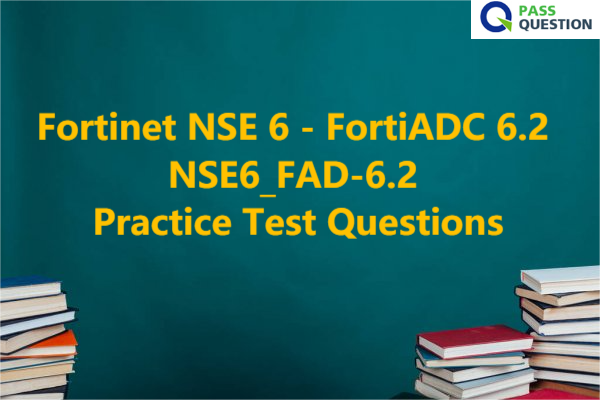Fortinet NSE 6 - FortiADC 6.2 NSE6_FAD-6.2 Practice Test Questions
Are you worried about your NSE6_FAD-6.2 Fortinet NSE 6 - FortiADC 6.2 exam? PassQuestion provides the latest Fortinet NSE 6 - FortiADC 6.2 NSE6_FAD-6.2 Practice Test Questions to help you to understand the topics and real exam patterns included in the exam and where to focus your energy. PassQuestion is the best site that provides you with the necessary NSE6_FAD-6.2 Practice Test Questions that will help you to get the Fortinet NSE6_FAD-6.2 exam the first time. It contains all the topics and the questions that will be asked in the real exam. The proficient Fortinet NSE 6 - FortiADC 6.2 NSE6_FAD-6.2 Practice Test Questions ensure your success in Fortinet NSE6_FAD-6.2 Exam on the first attempt.

Fortinet NSE 6 - FortiADC 6.2 Exam
The Fortinet NSE 6 - FortiADC 6.2 exam is part of the NSE 6 Network Security Specialist program, and certifies that the successful candidate has mastered important knowledge, skills, and abilities to deploy, configure, administer, manage and monitor FortiADC devices. This exam will test a candidate’s knowledge and skills related to basic to advanced configuration, day-to-day management of FortiADC devices, and using FortiADC to protect application delivery networks.
The Fortinet NSE 6 - FortiADC 6.2 exam is intended for security professionals involved in the configuration, administration, management, monitoring, and troubleshooting of FortiWeb devices in small to enterprise deployments
Exam Details
Exam name Fortinet NSE 6 - FortiADC 6.2
Exam series NSE6_FAD-6.2
Time allowed 60 minutes
Exam questions 30 multiple-choice questions
Scoring Pass or fail, a score report is available from your Pearson VUE account
Language English
Product version FortiADC 6.2
Exam Topics
Successful candidates have applied knowledge and skills in the following areas and tasks:
Deployment and System Configuration
- Identify deployment requirements
- Perform system configuration and management tasks
- Manage multi-vdom deployments
- Configure and manage FortiADC high-availability clusters
Server Load Balancing
- Configure virtual servers, real servers, server pools, and health checks
- Configure load balancing
- Configure traffic delivery optimization
- Configure global server load balancing
Advanced Networking and Security
- Configure poicy routing, QoS, and link load balancing
- Configure WAF and web vulnerability scanning
- Implement traffic security inspections and DoS protection
- Configure SSL offloading, acceleration and inspection
Scripting and REST API
- Manipulate traffic flow using LUA scripts
- Use REST API for system management
- Configure logging
View Online Fortinet NSE 6 - FortiADC 6.2 NSE6_FAD-6.2 Free Questions
When using FortiADC in a global load balancing configuration, in which two ways do general DNS settings differ from a global DNS policy? (Choose two.)
A.Traffic not matching a global DNS policy is served by the general DNS settings
B.Traffic matching source or destination criteria is served by the general DNS policy.
C.Traffic matching the zone, as well as both source and destination criteria, isserved by the global DNS policy.
D.Traffic not matching general DNS settings is served by a matching global DNS policy.
Answer: A, C
Which three statements about TurboHTTP are true?
A.It does not support content rewriting.
B.It is supported only on Layer 2 and layer 4 virtual servers.
C.It support the use of secured HTTP traffic.
D.It can be used with Layer 7 virtual servers.
E.It reduces network latency and system CPU usage.
Answer: A, D, E
An administrator wants to make sure their servers are protected against zero-day attacks.
Which FortiADC feature would they configure to accomplish this?
A.Advanced health checks
B.Advanced WVS
C.Signature-based IPS
D.Advanced WAF
Answer: D
An administrator is running the following sniffer on FortiADC:
Diagnose sniffer packet any ‘’port80’’ 2
What two pieces of information are included in the output of the sniffer? (Choose two.)
A.IP payload
B.Ethernet headers
C.Port names
D.IP headers
Answer: A, D
Which two actions can FortiADC take with the GeoIP block list when receiving requests from a blocked country's address space? (Choose two.)
A.Deny access
B.Redirect the request
C.Apply an HTTP protocol constraint
D.Send a 404 Not Found message
Answer: A, B
- TOP 50 Exam Questions
-
Exam
All copyrights reserved 2025 PassQuestion NETWORK CO.,LIMITED. All Rights Reserved.

